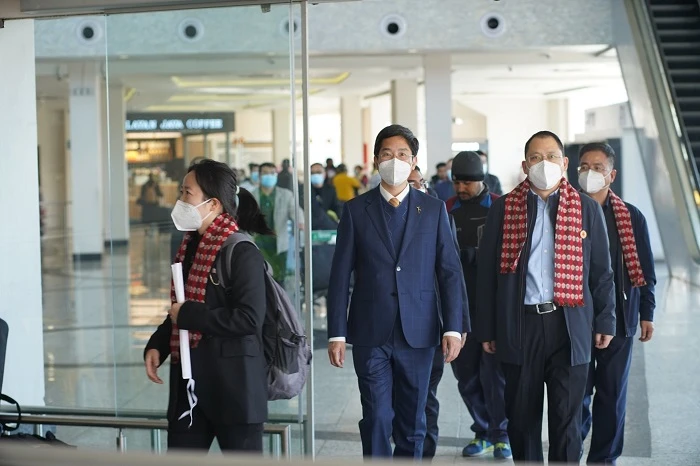Kathmandu: A team of Chinese railway experts arrived in Nepal on Tuesday to conduct a feasibility study and survey of a proposed Nepal-China cross-border railway project under the ambitious Belt and Road Initiative (BRI).
The technical team comprising six officials from the China Railway First Survey and Design Institute landed in Kathmandu on Tuesday afternoon.
The Chinese railway team’s visit comes barely three days after the formation of a new government under the leadership of Maoist party chief Pushpa Kamal Dahal aka Prachanda.
The expert team for the feasibility study & survey of China-Nepal Cross-Border Railway arrived today and welcomed by Charge d’affaires Wang Xin, important implementation of our leaders’ consensus and a solid step forward to turn Nepal from a land-locked to a land-linked country. pic.twitter.com/5Ku9wmtCc4
— Spokesperson Of Chinese Embassy In Nepal (@PRCSpoxNepal) December 27, 2022
On Monday, China had said that it would pursue projects under the BRI with Nepal while extending best wishes to Prachanda on his appointment to the country’s top executive job.
A senior official at Nepal’s Department of Railway, however, said that the Chinese team’s visit was planned earlier and has no link with the recent political developments in Nepal.
“As per Nepal’s request, China has agreed to provide grant assistance for the feasibility study of the railway,” he said, adding that the feasibility study may begin soon. The official also said that it might take at least 40 months to complete the feasibility study on the proposed railway.
Aman Chitrakar, senior divisional engineer at Nepal’s Department of Railway (DoR) said that they are scheduled to hold a dialogue with the visiting Chinese expert team on Wednesday and find out a way forward regarding carrying out the feasibility studies for the proposed railway.
“We will hold talks with the Chinese side on the feasibility of the railway which was delayed primarily due to the COVID-19 pandemic,” Chitrakar told local media.
Meanwhile, a spokesperson for Chinese Embassy in Kathmandu tweeted that the expert team came to Nepal to implement a consensus reached between the leaders from China and Nepal.
“It will be a solid step forward to turn Nepal from a land-locked to a land-linked country,” the embassy spokesperson said.
Once completed, the railway will link Tibetan Autonomous Region of China with Nepal’s capital Kathmandu. China has already linked Kerung with the Lhasa-Shigatse railway line on the Chinese side.
Given the tough Himalayan terrain, the railway project might encounter a plenty of technical challenges during its construction. There are also apprehensions in Nepal that the country might fall into China’s debt trap if it receives Chinese commercial loans with high interest rates to build such mega initiatives.
The former government led by Sher Bahadur Deuba, thus, had shown little interests to execute projects under the BRI including the railway. The railway is expected to cost at least $8 billion dollars.
The Chinese expert team visit follows an agreement between foreign ministers of Nepal and China on August 11, 2022, to utilize Chinese funds to support the feasibility study for the railway.
During their meeting in the eastern Chinese city of Shandong, Narayan Khadka, Nepal’s foreign minister and his Chinese counterpart Wang Yi had agreed to build the “Trans-Himalayan Multi-Dimensional Connectivity Network”.
A pre-feasibility on the railway which was conducted in 2018 indicated that the project would be among the toughest railways being pursued.
China will strengthen its sphere of influence and diplomacy to encircle India through loan/debt trap policies countries Nepal (Kerung-Kathmandu Rly Line), Pakistan (Gwadar port), and Sri Lanka (Hambantota Port) in IOR #DragonSabotagedSriLankahttps://t.co/8T9ZD4VdiE
— Mariya rashid (@binujan26) December 9, 2022
The estimated cost for the feasibility study of the 72-km cross-border railway will be around Nepali rupees 3.4 billion (180.47 million RMB), according to Nepali officials. Nepal and China have already discussed the ambitious railway project, but are yet to finalize its funding modalities. Nepal had signed a Memorandum of Understanding (MoU) on the Belt and Road with China in May 2017. However, it has not implemented a single project under the BRI yet.
(Santosh Ghimire is India Narrative’s Nepal correspondent based in Kathmandu)




















